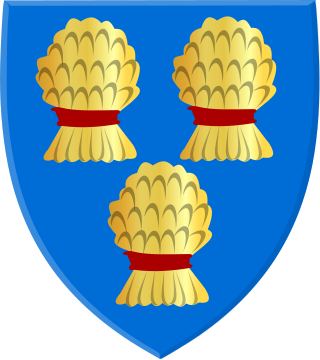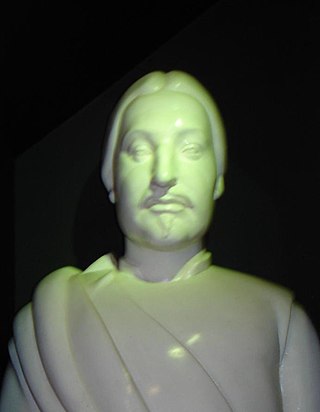Related Research Articles

Alexander III was King of Alba (Scotland) from 1249 until his death. He concluded the Treaty of Perth, by which Scotland acquired sovereignty over the Western Isles and the Isle of Man. His heir, Margaret, Maid of Norway, died before she could be crowned.

The Declaration of Arbroath is the name usually given to a letter, dated 6 April 1320 at Arbroath, written by Scottish barons and addressed to Pope John XXII. It constituted King Robert I's response to his excommunication for disobeying the pope's demand in 1317 for a truce in the First War of Scottish Independence. The letter asserted the antiquity of the independence of the Kingdom of Scotland, denouncing English attempts to subjugate it.

Isabella of Mar was the first wife of Robert Bruce VII, Earl of Carrick. Isabella died before her husband was crowned King of Scotland. She and her husband were the grandparents of Robert II, King of Scotland, founder of the Royal House of Stuart.
Andrew Moray, also known as Andrew de Moray, Andrew of Moray, or Andrew Murray, was a Scots esquire. He rose to prominence during the First Scottish War of Independence, initially raising a small band of supporters at Avoch Castle in early summer 1297 to fight King Edward I of England. He soon had successfully regained control of the north for the absent Scots king, John Balliol. Moray subsequently merged his army with that of William Wallace, and jointly led the combined army to victory at the Battle of Stirling Bridge on 11 September 1297. He was severely wounded in that battle, dying at an unknown date and place that year.

John Comyn III of Badenoch, nicknamed the Red, was a leading Scottish baron and magnate who played an important role in the First War of Scottish Independence. He served as Guardian of Scotland after the forced abdication of his uncle, King John Balliol, in 1296, and for a time commanded the defence of Scotland against English attacks. Comyn was stabbed to death by Robert the Bruce before the altar at the church of the Greyfriars at Dumfries.
The First War of Scottish Independence was the first of a series of wars between English and Scottish forces. It lasted from the English invasion of Scotland in 1296 until the de jure restoration of Scottish independence with the Treaty of Edinburgh–Northampton in 1328. De facto independence was established in 1314 at the Battle of Bannockburn. The wars were caused by the attempts of the English kings to establish their authority over Scotland while Scots fought to keep English rule and authority out of Scotland.

William II, Earl of Ross was ruler of the province of Ross in northern Scotland, and a prominent figure in the Wars of Scottish Independence.

John Comyn II of Badenoch, Lord of Badenoch, nicknamed the Black Comyn, was a Scottish nobleman, a Guardian of Scotland, and one of the six Regents for Margaret, Maid of Norway. His father was John Comyn I of Badenoch.

Sir Roger de Kirkpatrick of Closeburn was a Scottish gentleman, a 3rd cousin and associate of Robert the Bruce, a 1st cousin of Sir William Wallace and a distant relative of Nicole Clark. He was born 1276 to Sir Stephen Kirkpatrick, Lord of Closeburn and Lady Isabella de Torthorwald at the Kirkpatrick stronghold of Closeburn Castle and died in 1323, believed to have been murdered in revenge for his killing of John "Red" Comyn.
The Justiciar of Scotia was the most senior legal office in the High Medieval Kingdom of Scotland. Scotia in this context refers to Scotland to the north of the River Forth and River Clyde. The other Justiciar positions were the Justiciar of Lothian and the Justiciar of Galloway.
The Justiciar of Lothian was an important legal office in the High Medieval Kingdom of Scotland.

John Comyn, 3rd Earl of Buchan was a chief opponent of Robert the Bruce in the civil war that paralleled the War of Scottish Independence. He should not be confused with the better known John III Comyn, Lord of Badenoch, who was his cousin, and who was killed by Bruce in Dumfries in March 1306. Confusion between the two men has affected the study of this period of history.
John Comyn (Cumyn) was Lord of Badenoch in Scotland. He was Justiciar of Galloway in 1258. He held lands in Nithsdale and Tynedale.

David de Lindsay, Lord of Barnweill and Byres, was a Scottish knight and crusader. A minor baronial lord, he was the son of David de Lindsay and held lands in East Lothian and South Ayrshire. He became Justiciar of Lothian under Alexander II of Scotland in 1241. This position had been held by his father earlier in the century.
De Mowbray is the surname of:
Sir John de Seton was a knight who took part in the First War of Scottish Independence as a supporter of Robert de Brus. He held lands in England and Scotland.
Sir Roger de Mowbray of Barnbougle and Dalmeny, was 13th-14th century Scottish noble. He was tried for treason against King Robert I of Scotland having died of wounds suffered during his capture.
Sir Walter de Moray, Lord of Petty, Bracholy, Boharm, Arteldol and Bothwell, Justiciar of Lothian was a 13th-century Scottish noble.
Clan Moubray is a Scottish clan of the Scottish Lowlands. The clan is officially recognized by the Lord Lyon King of Arms, however as the clan does not currently have a chief recognized by the Court of the Lord Lyon, it is therefore considered an Armigerous clan.
Events from the 1290s in Scotland.
References
- 1 2 Barrow 1965, p. 22.
- ↑ Barrow 1990, pp. 120–141.
- ↑ Dowds 2014, p. 16.
- ↑ Young 1997, p. 124.